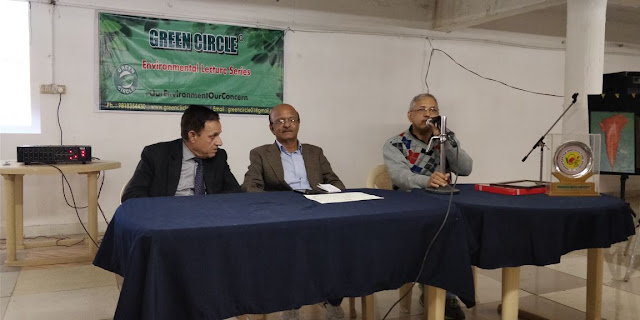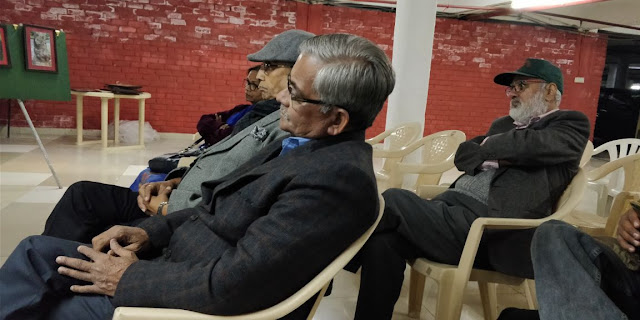Deforestation is a neglected concern for air pollution
(Round Table on Pollution - causes, concerns and solutions)
V Selvarajan Founder Green Circle
Panelist in the round table on 22.12.18 organised by Chetna
An effort is made in this paper to correlate the impact of deforestation on air pollution and suggest corrective measures to revisit the present status of pollution control measures in the pretext of ongoing deforestation in Delhi
GRAP measures need changes
 A study conducted on behalf of the Delhi Government by IIT-Kanpur on air pollution in the city published in 2016 stated there were 13 key pollution sources and their relative contributions to different pollutants fouling up the air. These include dust sources such as road dust and construction dust as well as a large number of combustion sources namely vehicles, power plants, industries and waste burning. Air Pollution in Delhi is formidable and while everyone is highly concerned about the control of the pollution level, the measures outlined in the form of Graded response action plan (GRAP) by MoEFCC/CPCB does not appear to be concerned about forests or consider tree as a pollution control tool despite the apparent fact that the carbon absorption capacity is gifted by nature only to trees on the planet earth. The increased forest cover is the best pro-active measure to make Carbon reduction possible. Under this backdrop, the author is of the strong opinion that the GRAP measures listed out by the department be revisited to include increased forest cover as an air pollution control measure
A study conducted on behalf of the Delhi Government by IIT-Kanpur on air pollution in the city published in 2016 stated there were 13 key pollution sources and their relative contributions to different pollutants fouling up the air. These include dust sources such as road dust and construction dust as well as a large number of combustion sources namely vehicles, power plants, industries and waste burning. Air Pollution in Delhi is formidable and while everyone is highly concerned about the control of the pollution level, the measures outlined in the form of Graded response action plan (GRAP) by MoEFCC/CPCB does not appear to be concerned about forests or consider tree as a pollution control tool despite the apparent fact that the carbon absorption capacity is gifted by nature only to trees on the planet earth. The increased forest cover is the best pro-active measure to make Carbon reduction possible. Under this backdrop, the author is of the strong opinion that the GRAP measures listed out by the department be revisited to include increased forest cover as an air pollution control measure
Air Pollution vs trees
The relationship between trees and air pollution is a complex one. It is necessary to assess whether the deforestation has a direct bearing on air pollution levels. In Delhi the major contributor to the air pollution is in the form of PM .5 and PM 10. These Particulate matter suspended in polluted air tends to settle on leaves and certain gases including nitrous dioxide (NO2) are absorbed by leaves’ stomata, filtering the air and reducing pollution levels slightly.
But it is apprehended that the trees and other vegetation restrict airflow in their immediate vicinity, preventing pollution from being diluted by currents of cleaner air. In particular, tall trees with thick canopies planted alongside busy roads can act like a roof, trapping pockets of polluted air at ground level. While the significance of this thought needs scientific evidences, to improve air quality, city planners need to give careful consideration to how trees are spaced while going for massive plantation. This can be a realistic option since the unmindful planting of trees lack farsightedness
Delhi’s status of forest
 The National Forest Policy, 1988 provides that a minimum of 1-3rd of the total land area of the country should be under forest area. As per 2015 status report of forests, Delhi has 299.58 sq km of land under forest which accounts for 20.22 % of the Geographic area which means still we are lagging behind in tree cover. Out of this, 111 sq. kms is TREE COVER and 188.77 sq. kms. is FOREST COVER making a total of 299.77 sq. kms. In the light of tall claims of huge forest cover in Delhi, we need to analyse the status of forests in the light of the official definitions offered by forest department which has provided the above data.
The National Forest Policy, 1988 provides that a minimum of 1-3rd of the total land area of the country should be under forest area. As per 2015 status report of forests, Delhi has 299.58 sq km of land under forest which accounts for 20.22 % of the Geographic area which means still we are lagging behind in tree cover. Out of this, 111 sq. kms is TREE COVER and 188.77 sq. kms. is FOREST COVER making a total of 299.77 sq. kms. In the light of tall claims of huge forest cover in Delhi, we need to analyse the status of forests in the light of the official definitions offered by forest department which has provided the above data.
What is Forest cover? The term 'Forest Cover' as used in the 'SFR' refers to all lands more than one hectare in area, having a tree canopy density of more than 10%. Assuming that the forest department has accounted forest cover at this ratio, then it goes without saying that all the accounted forest area of 188.77 Sq KMs will have just in reality counts for 10% of it. In other words, the greenery in these area may be just 19 Sq KMs of actual forests or just a little more of it. Let’s assume that it may be 25 Sq KMs on a ‘generous’ accounting (extrapolation of data is quite a common thing in statistical methods). The term 'Forest Area' (or recorded forest area) generally refers to all the geographic areas recorded as forest in government records. Recorded forest areas largely comprise Reserved Forests (RF) and Protected Forests (PF), which have been constituted under the provisions of Indian Forest Act, 1927. Besides RFs and PFs, the recorded forest area may include all such areas, which have been recorded as forests in the revenue records or have been constituted so under any State Act or local laws.
What is Tree cover? Tree cover comprises of tree patches outside the recorded forest area exclusive of forest cover and less than the minimum mapable area (1 ha). These lands are not recorded forest area as per definition above. Such areas may include orchards, bamboo and palm also which may not produce much oxygen or filter much carbon emissions. However in the definition of These trees are also
 What is forest then? Obviously the Forest cover as well as Tree Cover account for the term 'forest” which means that the presence of trees over private areas or residential areas too also account for the forest area. This is how Delhi has a forest of 299.77 Sq Kms which included 111 sq. kms tree cover and 188.77 sq. kms forest cover.
What is forest then? Obviously the Forest cover as well as Tree Cover account for the term 'forest” which means that the presence of trees over private areas or residential areas too also account for the forest area. This is how Delhi has a forest of 299.77 Sq Kms which included 111 sq. kms tree cover and 188.77 sq. kms forest cover.
If Delhi flaunts that it has forest to the tune of a fifth of the Geographic area of 1500 sq km, it is indeed a farce and just a play with the jugglery of definitions and an effort to shut the mouths of the conscious citizens. Real efforts should be made using satellite mapping and scientific technologies.
Saving Trees to prevent pollution
Chipko Movement of South Delhi brought many of us together. 16500 trees were at stake in South Delhi, India Gate trees are awaiting axe. Atul Khataria Chowk is ready for felling, Noida is almost finished. Aravali will be a history soon. Dwarka Express way is going to end another 3000 trees. Things are not moving in good direction despite our concerted efforts to fight against the double giants NBCC and CPWD. Any moment axe may fall on the trees. If the tree cover is not sufficient we go for planting new trees which take at least 30 years to reach an acceptable definition of TREE. But cutting well grown trees is not stopped though our movement has prevented. The ongoing construction activities will increase AQI for sure, but are we going to allow that. Answer is an emphatic YES and NO which squarely depends on civic society’s conviction. An ordinary Delhi citizen rarely comes out for fighting against any Social evil whether it is a child abuse, women empowerment, corruption in public life, pollution or tree felling. But a concerted effort an selfless service for saving a tree is essential. Right under our nose many trees are dying a slow death. We have identified many concerns such as nailing, concretisation, termite infection, Amar bel onslaught, natural disasters like uprooting of trees etc. Pruning of leaves is another issue.
While Delhi Tree Act stipulates norms, we come across cases where trees are pruned unmindful of standard pruning norms. No enforcement is in place against the perpetrators of the crime. Very soon, we will have to rename the popular residential areas in South Delhi in particular as Kidwainagar desert, Netaji nagar desert etc Instead of going to Rajastan Jaisalmir to see deserts, we can soon see camels walking in Delhi. The author is of the opinion that the present pattern of planting of trees is neither scientific not sustainable. During the last season, the Delhi Government has gone for massive plantation and all departments were given quantitative target. In their anxiety to achieve the given target in the short span of monsoon days, departments were seen planting homogenous trees wherever space was available. Choice of trees was also not done with proper homework on the sustainable species. .In many cases, it was seen that ornamental plants were planted just to reach the numerical targets. Planting trees in platforms and then concretizing the platforms have led to the death and decay of the existing trees.
Saving an existing tree is more important than planting 10 new trees which will take years to bring the expected results. Further the tree care must focus on removing parasitic creepers such as Amar Bel (Cuscuta) and termite infection. Focus for new tree plantation must take into account the Indigenous species, long term planning for spacing, avoidance of ornamental and homogenous plantation besides ensuring regular watering






































